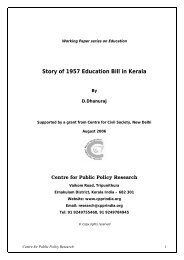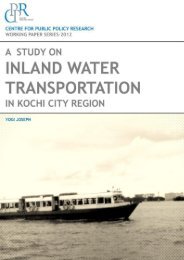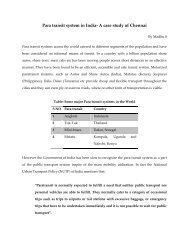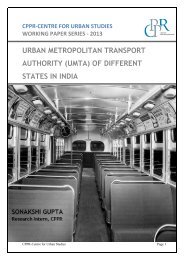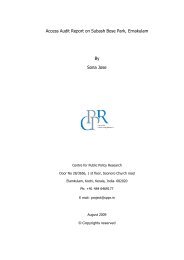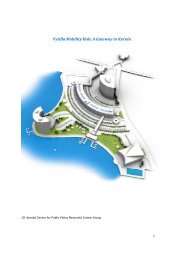Conservation of Natural Springs in Western Ghats - CPPR
Conservation of Natural Springs in Western Ghats - CPPR
Conservation of Natural Springs in Western Ghats - CPPR
Create successful ePaper yourself
Turn your PDF publications into a flip-book with our unique Google optimized e-Paper software.
Work<strong>in</strong>g Paper series on Community management <strong>of</strong> Dr<strong>in</strong>k<strong>in</strong>g Water Schemes<strong>Conservation</strong> <strong>of</strong> <strong>Natural</strong> <strong>Spr<strong>in</strong>gs</strong> <strong>in</strong> <strong>Western</strong> <strong>Ghats</strong>ByD.DhanurajSupported by a grant from Centre for Civil Society, New DelhiJune 2006Centre for Public Policy ResearchVaikom Road, TripunithuraErnakulam District, Kerala India – 682 301Website: www.cppr<strong>in</strong>dia.orgEmail: research@cppr<strong>in</strong>dia.orgTel: 91 9249755468, 91 9249784945Copy rights reserved © 2006Centre for Public Policy Research 1
<strong>Conservation</strong> <strong>of</strong> <strong>Natural</strong> <strong>Spr<strong>in</strong>gs</strong> <strong>in</strong> <strong>Western</strong> <strong>Ghats</strong>Kerala is known as God’s own country. The state is marvellous with its greenery. Thestate is known for its ravish<strong>in</strong>g beauty crisscrossed with lagoons, rivers and back waters.But over the years, Kerala has witnessed shortage <strong>of</strong> dr<strong>in</strong>k<strong>in</strong>g water. The reasons<strong>in</strong>clude improper usage <strong>of</strong> dr<strong>in</strong>k<strong>in</strong>g water, pollution <strong>of</strong> water resources, limited supply <strong>of</strong>the water, lack <strong>of</strong> treatment facilities, unassailable water resources and so on. Keralahas a costal l<strong>in</strong>e <strong>of</strong> Kilometres. Mounta<strong>in</strong>s and hillocks form the boundary at theeastern side. The mid land is plane accord<strong>in</strong>g to the geography <strong>of</strong> the state.Pazhakulam Service Society (PASSS) situated at Pazhakulam near to Adoor, Kerala isactive <strong>in</strong> various social activities. It was <strong>in</strong> the beg<strong>in</strong>n<strong>in</strong>g <strong>of</strong> 1990’s PASSS proposed thecollection <strong>of</strong> natural spr<strong>in</strong>gs <strong>in</strong> order to use it as a safe dr<strong>in</strong>k<strong>in</strong>g water. In the <strong>in</strong>itialstages it was an experimental one. Later it was proved to be a viable and susta<strong>in</strong>ableone and cont<strong>in</strong>ued to build up to 1500 schemes at various locations <strong>in</strong> Southern Kerala.These localities are enriched with natural spr<strong>in</strong>g spots and till then these spr<strong>in</strong>gs werenever utilised for the effective consumption for dr<strong>in</strong>k<strong>in</strong>g water. The objectives <strong>of</strong> thescheme <strong>in</strong>cluded the regulated exploitation <strong>of</strong> ground water with the support <strong>of</strong> the localcommunity and their <strong>in</strong>volvement <strong>in</strong> the scheme <strong>of</strong> th<strong>in</strong>gs 1 . This has widened thecoverage <strong>of</strong> the accessibility <strong>of</strong> safe dr<strong>in</strong>k<strong>in</strong>g water to rural people and brought thevarious actors <strong>in</strong> a provider group to a collective organ <strong>in</strong> the course <strong>of</strong> time. The<strong>in</strong>titative taken by PASSS has successfully worked out with the local community atvarious places and set the role model for the similar <strong>in</strong>itiatives across the state. The firstyear was more or less an <strong>in</strong>cubation period for the projects. Dur<strong>in</strong>g this time, the Societywas also prov<strong>in</strong>g the advantages and meritocracy <strong>of</strong> the projects undertaken.In the first year, seventy seven projects were supported by Netherlands Government.Even though the project completion was expected with<strong>in</strong> a year, later it was extended tothree years. After the completion <strong>of</strong> the first phase <strong>of</strong> the project, many other dr<strong>in</strong>k<strong>in</strong>gwater projects along the same l<strong>in</strong>es <strong>of</strong> already completed were mooted andimplemented <strong>in</strong> three districts <strong>of</strong> Southern Kerala namely Thiruvanathapuram, Kollam,Alapuzha and Pathanamitta.<strong>Natural</strong> spr<strong>in</strong>gsUnderground water com<strong>in</strong>g to the surface <strong>of</strong> the earth through pores is called spr<strong>in</strong>gs. Itis frequently seen at the valley side <strong>of</strong> the hills. The quantity <strong>of</strong> the water com<strong>in</strong>g outdepends on the availability <strong>of</strong> the ra<strong>in</strong>. <strong>Western</strong> <strong>Ghats</strong> come under the ra<strong>in</strong> shadowareas and it is rich with ra<strong>in</strong>s. There are water spr<strong>in</strong>gs which pump the water throughoutthe year. There are two types <strong>of</strong> natural spr<strong>in</strong>gs seen <strong>in</strong> the <strong>Western</strong> <strong>Ghats</strong>; Gravityspr<strong>in</strong>gs and artificial spr<strong>in</strong>gs.1 PASSS, p.8Centre for Public Policy Research 2
1. Gravity spr<strong>in</strong>gsIf the rocks underneath are solid enough prevent<strong>in</strong>g the water percolation tobeneath, the collected water will come through the possible open<strong>in</strong>gs <strong>in</strong> thesurface.2. Artificial spr<strong>in</strong>gsIf the layer <strong>of</strong> rocks which forbids the flow <strong>of</strong> water are vulnerable, the pressure<strong>of</strong> water will automatically exert the pump<strong>in</strong>g through the pores creat<strong>in</strong>g acont<strong>in</strong>uous flow.On the western <strong>Ghats</strong>, more gravity spr<strong>in</strong>gs are observed. PASSS has come outwith a hand book which expla<strong>in</strong>s the various gravity spr<strong>in</strong>gs seen <strong>in</strong> Kerala andhow they vary each other. It helps everyone to understand the resourcesaccord<strong>in</strong>gly and the variation and care needed while convert<strong>in</strong>g these resources<strong>in</strong>to community schemes. The different spr<strong>in</strong>gs <strong>in</strong>clude gravity depressionspr<strong>in</strong>gs, gravity overflow spr<strong>in</strong>gs, gravity contact spr<strong>in</strong>gs and structural or fissurespr<strong>in</strong>gs. It varies accord<strong>in</strong>g to the location and the topography <strong>of</strong> the region.Accord<strong>in</strong>g to PASSS, the objectives <strong>of</strong> the schemes are:1. Provide dr<strong>in</strong>k<strong>in</strong>g water even <strong>in</strong> the remotest <strong>of</strong> areas which are hilly and2. Utilise ground water <strong>in</strong> a better and susta<strong>in</strong>able way3. Involvement <strong>of</strong> community <strong>in</strong> the dr<strong>in</strong>k<strong>in</strong>g water projects4. Understand the value <strong>of</strong> the safe dr<strong>in</strong>k<strong>in</strong>g water and thus ensure thesanitation and hygiene.5. Capital cost shar<strong>in</strong>g to set up the projects.PASSS had been work<strong>in</strong>g <strong>in</strong> the area <strong>of</strong> capacity build<strong>in</strong>g for many years by thetime the organisation stepped <strong>in</strong>to the dr<strong>in</strong>k<strong>in</strong>g water projects. This ensured theacceptability and loyalty among the mass. PASSS <strong>in</strong>teract with the Panchayatmembers and local community leaders to understand the nature and scope <strong>of</strong>the projects at various places. A technical team compris<strong>in</strong>g eng<strong>in</strong>eers,representatives <strong>of</strong> local governments and NGOs study the feasibility <strong>of</strong> theproject and its success formula.The projects are successful <strong>in</strong> promot<strong>in</strong>g cost shar<strong>in</strong>g, community managementcost recovery and Operation and Management <strong>of</strong> the schemes. This has broughttogether the various stake holders <strong>in</strong>to the same fold <strong>in</strong>clud<strong>in</strong>g the policy makers,technical experts, Government <strong>of</strong>ficials and locals. This has ensured theimplementation <strong>of</strong> the water scheme projects at lower rate compared to the highcost <strong>in</strong>volved <strong>in</strong> the Government schemes. After the first stage, ma<strong>in</strong>tenance andsurveillance have been given to the water committees. Water committee <strong>in</strong>cludesthe local people and the Panchayat members from time to time. Where PASSS isactive through the farm clubs, their representatives are also <strong>in</strong>cluded. Butmostly, committees are left to the local community.The cost <strong>in</strong>volved <strong>in</strong> the construction was met by PASSS from its funds. Sometimes, partial assistance was received from the local Panchayat. Flexibility andCentre for Public Policy Research 3
adaptability <strong>in</strong> the local environment are taken <strong>in</strong>to consideration when a newproject is considered.The per capita cost <strong>of</strong> the spr<strong>in</strong>g schemes was below Rs. 300 <strong>in</strong> most <strong>of</strong> thecases 2 . The match<strong>in</strong>g fund was started by the Panchayat as a result <strong>of</strong> thecredibility <strong>of</strong> the schemes was proved. Over a period <strong>of</strong> six years, thecontribution <strong>of</strong> the Panchayat was <strong>in</strong>creased from 6.4% to 22.4% 3 . If the firstphase was funded by the Netherlands embassy, the subsequent phases werefunded by SIMAVI Foundation Netherlands.Once the spr<strong>in</strong>gs are located, beneficiary groups are identified. The identification<strong>of</strong> the spr<strong>in</strong>gs are based on certa<strong>in</strong> criterion like the number <strong>of</strong> beneficiaries,reliability on the resource, chances <strong>of</strong> gett<strong>in</strong>g polluted, quantity <strong>of</strong> water <strong>in</strong> peaksummer times, quality <strong>of</strong> the water and per capita cost. It is assured that socialbudget<strong>in</strong>g meets the requirements.PASSS builds a community base wherever they operate. Their representativesvisit the house holds and hold discussions with the members <strong>in</strong> the family Ithelps to understand the local environment. Interest and awareness can begauged from such <strong>in</strong>teractions. The economic standards and the life style pattern<strong>of</strong> different beneficiaries are discussed <strong>in</strong> these meet<strong>in</strong>gs. In the next phase, thegroup calls for a public meet<strong>in</strong>g <strong>in</strong> the proposed localities and takes classes onspr<strong>in</strong>gs. It generates much needed awareness, which would def<strong>in</strong>itely help <strong>in</strong>susta<strong>in</strong><strong>in</strong>g the projects <strong>in</strong> longer run. The beneficiary groups are formed at thisstage. It works as a neighbourhood group. In the <strong>in</strong>itial stages when RoyalNetherlands embassy was support<strong>in</strong>g the projects, no beneficiary groups wereformed. Later <strong>in</strong> the subsequent stages, beneficiary groups were formed. Thenumber <strong>of</strong> members <strong>in</strong> the executive committee <strong>of</strong> the beneficiary group varied<strong>in</strong> each phase. When it was <strong>in</strong>troduced the number was four; tow men and twowomen. Later, it was raised to five where two men and three womencoord<strong>in</strong>ated the monitor<strong>in</strong>g. The <strong>in</strong>crease <strong>in</strong> women members was a tacticalmove especially <strong>in</strong> the context <strong>of</strong> Kerala. Women are more <strong>in</strong>volved <strong>in</strong> collect<strong>in</strong>gwater for the daily requirements.In the user beneficiary group meet<strong>in</strong>gs, discussions on the provisions for thefunds, technical design, follow-ups and monitor<strong>in</strong>g mechanisms are held. All themembers <strong>in</strong> the families <strong>of</strong> the users participate <strong>in</strong> the meet<strong>in</strong>g. The wardmember to the Panchayat, PASSS representative, Health departmentrepresentative and local Anganwadi teacher also attend the meet<strong>in</strong>g. Themeet<strong>in</strong>gs are arranged after 5 pm <strong>in</strong> the even<strong>in</strong>g for the convenience <strong>of</strong> the userbeneficiaries. Some times the requirements would be very high so that at least 3to 7 meet<strong>in</strong>gs are convened before the project implementation. They aredescribed below:2 Balachandra Kurup, p.23 Balachandra Kurup, p.2Centre for Public Policy Research 4
Meet<strong>in</strong>g No 1This meet<strong>in</strong>g is convened by PASSS coord<strong>in</strong>ator. He expla<strong>in</strong>s how these projectscan be assisted by PASSS and what they expect from the user beneficiaries. Onthe basis <strong>of</strong> the outcome <strong>of</strong> the meet<strong>in</strong>g, decision on whether the dr<strong>in</strong>k<strong>in</strong>g waterprojects are required <strong>in</strong> that locality is decided. To what extend the cooperationand support could be expected from the community is also discussed.Meet<strong>in</strong>g No 2A water committee is formed for the successful implementation <strong>of</strong> the project.Members to the committee are selected from the users. PASSS farm clubrepresentative and Panchayat member are also members <strong>in</strong> the committee. Aconvenor is elected from the members. Instructions are given to the members onthe responsibility and their duties.Meet<strong>in</strong>g 3In this phase, discussion ranges on the construction style. Which style would bemore suitable to the users is taken <strong>in</strong>to consideration. Accord<strong>in</strong>g to therequirements, technical plann<strong>in</strong>g is prepared. Availability <strong>of</strong> the constructionmaterials and the required quantity <strong>in</strong> the local context are assessed <strong>in</strong> thisstage. This helps to calculate the amount required for implementation <strong>of</strong> theproject. Usually, 25 % to 40% <strong>of</strong> the total cost is borne by the users and the restis allotted from the plan outlay. Sometimes, the user’s contribution may be <strong>in</strong>terms <strong>of</strong> their labour or provid<strong>in</strong>g the build<strong>in</strong>g materials <strong>in</strong> case the monetarycontributions are not possible. The committee meet<strong>in</strong>g decides on each one’scontribution after hear<strong>in</strong>g each user.Meet<strong>in</strong>g 4Once the beg<strong>in</strong>n<strong>in</strong>g <strong>of</strong> the work is scheduled, the water committee publishes atable <strong>in</strong> which the contribution <strong>of</strong> each user is mentioned. In case, if thecontribution is <strong>in</strong> terms <strong>of</strong> labour, the work schedule for each family or user isalso f<strong>in</strong>alised <strong>in</strong> this meet<strong>in</strong>g.Meet<strong>in</strong>g 5This is a mid term evaluation meet<strong>in</strong>g <strong>in</strong> the course <strong>of</strong> construction work. Theprogress <strong>of</strong> the work is discussed. If there are any defects or compla<strong>in</strong>ts, theyare heard and the remedies are suggested.Meet<strong>in</strong>g 6This meet<strong>in</strong>g is held after the completion <strong>of</strong> the work. Evaluation <strong>of</strong> the projecttill then is done <strong>in</strong> this meet<strong>in</strong>g. The future plans are also mooted <strong>in</strong> the meet<strong>in</strong>g.Focus <strong>of</strong> the meet<strong>in</strong>g is the effective utilisation <strong>of</strong> dr<strong>in</strong>k<strong>in</strong>g water. Tra<strong>in</strong><strong>in</strong>g isCentre for Public Policy Research 5
provided <strong>in</strong> case <strong>of</strong> any compla<strong>in</strong>ts to the work<strong>in</strong>g <strong>of</strong> the hand pipes used. Forthe repair<strong>in</strong>g and ma<strong>in</strong>tenance purposes, Rs 5 is collected from each family everymonth and deposited <strong>in</strong> the near by post <strong>of</strong>fice under the jo<strong>in</strong>t account <strong>of</strong> theconvenor and a committee member.Responsibilities <strong>of</strong> water committees1. Educate the users on the benefits <strong>of</strong> water available fro the spr<strong>in</strong>gs and the needto susta<strong>in</strong> it through the effective utilisation <strong>of</strong> the same.2. Motivate users by encourag<strong>in</strong>g them to develop and utilise the possibleresourceful spr<strong>in</strong>gs.3. Encourage the users to provide the required build<strong>in</strong>g materials for theconstruction.4. Pool the construction materials to speed up the process.5. F<strong>in</strong>d out the technically sound labours for the construction activities.6. Provide the leadership for the project implementation.7. Collect Rs 5 every month from each family and deposit <strong>in</strong> the jo<strong>in</strong>t account heldby the convenor and the member <strong>in</strong> the nearby post <strong>of</strong>fice.8. Select two users for tra<strong>in</strong><strong>in</strong>g and ma<strong>in</strong>tenance <strong>of</strong> the hand pumps.9. If required, take care <strong>of</strong> chlor<strong>in</strong>ation <strong>of</strong> water and its proper applications.10. In the case <strong>of</strong> repair<strong>in</strong>g, monitor<strong>in</strong>g is done.11. Recod<strong>in</strong>g <strong>of</strong> the day to day ma<strong>in</strong>tenance and keep<strong>in</strong>g the meet<strong>in</strong>g held at leastonce <strong>in</strong> a month.12. Promote basic rights, responsibility and desirable behaviour concern<strong>in</strong>g wateruse, the use <strong>of</strong> sanitation facilities and ma<strong>in</strong>tenance <strong>of</strong> a hygienic villageenvironment.Members who do not attend three consecutive meet<strong>in</strong>gs shall forfeit theirmembership and any member who is not active can be removed from thecommittee. Water Committees will monitor the water usage, various dis<strong>in</strong>fectionmethods and frequency <strong>of</strong> dis<strong>in</strong>fection. All the monetary transactions, labourcontribution, and <strong>in</strong>volvement <strong>of</strong> various stakeholders are recorded and kept <strong>in</strong> a filefor future references. Thus, water committees can act as an effective agency forplann<strong>in</strong>g, implementation and management <strong>of</strong> schemes.In the <strong>in</strong>itial meet<strong>in</strong>gs itself, if the meet<strong>in</strong>gs decide on the projects and spr<strong>in</strong>glocation, an understand<strong>in</strong>g is reached on the usage <strong>of</strong> the water among themembers. In these cases, s<strong>in</strong>ce the resource here is natural spr<strong>in</strong>gs, there is noquantity <strong>of</strong> water to be assigned to each user. In these circumstances, work ups aredone on the basis <strong>of</strong> availability <strong>of</strong> the water <strong>in</strong> these spr<strong>in</strong>gs throughout the year.Mostly, the projects are implemented where availability <strong>of</strong> the water is assured.There is no pause or stoppage for the water flow <strong>in</strong> these spr<strong>in</strong>gs. If the spr<strong>in</strong>gs arefound <strong>in</strong> the private land, an agreement is reached between the owners and watercommittee on the purposeful usage <strong>of</strong> the water. Water committee educate theusers on the necessity <strong>of</strong> be<strong>in</strong>g harmless to the owner while tak<strong>in</strong>g water from hisproperty.Centre for Public Policy Research 6
Quality <strong>of</strong> the water is tested before the decision is taken to implement the project.Sample is sent to the laboratories. If the water is polluted, practical solutions aresought. Other factors <strong>in</strong>fluence the solution <strong>in</strong>cludes the type <strong>of</strong> resource, availability<strong>of</strong> water, position <strong>of</strong> the resource, soil structure, number <strong>of</strong> beneficiaries, requiredquantity and the cost <strong>in</strong>volved. Studies are also conducted on the possibility <strong>of</strong> thechances <strong>of</strong> gett<strong>in</strong>g polluted <strong>in</strong> the future also and necessary steps are taken to solvethe issues.Construction phaseGenerat<strong>in</strong>g po<strong>in</strong>t <strong>of</strong> spr<strong>in</strong>t is found out. The surround<strong>in</strong>g areas are cleaned.Depend<strong>in</strong>g on the quantity <strong>of</strong> water available, number <strong>of</strong> users and soil structure,size and position <strong>of</strong> the stor<strong>in</strong>g tank is estimated. The stream flow <strong>of</strong> water dur<strong>in</strong>gmonsoon is also considered dur<strong>in</strong>g this stage. If the stor<strong>in</strong>g tank cannot beconstructed adjacent to the natural spr<strong>in</strong>g, small pits are constructed and these pitsare used for temporary storage <strong>of</strong> the water. Then these pits are connected to alarger reservoir.There are many spr<strong>in</strong>gs developed by <strong>in</strong>dividuals <strong>in</strong> their own property. Most <strong>of</strong> thenatural spr<strong>in</strong>g projects are constructed <strong>in</strong> the private land and the cost is fully ormostly funded by the owners <strong>of</strong> the private lands. In Kerala context, the owners <strong>of</strong>the private land always fear about the claims that other users may have <strong>in</strong> the futureon the property he owns. So <strong>in</strong> most <strong>of</strong> the cases, the owner himself spends moneyfor the project and reta<strong>in</strong>s his rights over all the constructions <strong>in</strong> his property. Thenhe reaches a Memorandum <strong>of</strong> Understand<strong>in</strong>g (MoU) with the community. The watercommittee negotiates and persuades the owner and the community to reach anagreement. Especially <strong>in</strong> the <strong>in</strong>itial stages when Panchayat was not <strong>in</strong>volved as <strong>in</strong> thelatter phases, private lands were more used.Accord<strong>in</strong>g to the available data, the number <strong>of</strong> users varies from 20 to 80 per aspr<strong>in</strong>g. 90 % <strong>of</strong> the users come under Below Poverty L<strong>in</strong>e (BPL) status. The costshar<strong>in</strong>g <strong>of</strong> the project is a remarkable achievement <strong>of</strong> the project. There is acollective upris<strong>in</strong>g and the community development as result. Efficiency <strong>of</strong> theprojects resulted <strong>in</strong> more contributions from the community side <strong>in</strong> the subsequentphases.Table 1Capital cost shar<strong>in</strong>g <strong>in</strong> the Phases <strong>of</strong> the ProjectPhases ProjectPanchayatBeneficiary ContributionContribution (Per Contribution (Per (Per centage)Centage) centage)Phase 1 92.4 Nil 7.6Phase 2 77.2 Nil 22.8Phase 3 73.8 6.4 19.8Phase 4 61.1 22.4 16.5Source: Dr K Balachandra Kurup, p.13Centre for Public Policy Research 7
At least five families will be <strong>in</strong>volved when a new project proposal is considered.When PASSS mooted the proposal to fund<strong>in</strong>g agencies, the estimate for develop<strong>in</strong>g asite was Rs 9,000. But due to various other factors, the cost <strong>of</strong> the each site rangedupto Rs 20,000. Most <strong>of</strong> the times, the terra<strong>in</strong> and the location <strong>in</strong>creased the cost.To most <strong>of</strong> these hilly rocks, transportation facilities were not available and it<strong>in</strong>creased the labour charges. Even then the average per capita cost was found to beRs 300 under this project. Collection <strong>of</strong> Rs 5 every month from each family hasconsiderably met the ma<strong>in</strong>tenance cost.Compared to the other dr<strong>in</strong>k<strong>in</strong>g water projects, the availability <strong>of</strong> the water isassured <strong>in</strong> the natural spr<strong>in</strong>gs. As mentioned above, construction activities are doneonly after assess<strong>in</strong>g the replenish<strong>in</strong>g nature <strong>of</strong> the resources. At an average, eachfamily gets 100 to 300 litres <strong>of</strong> water per day. This cannot be generalised on purestatistical data as the spr<strong>in</strong>gs never get dry even <strong>in</strong> the peak summer periods onlythe quantity <strong>of</strong> water available is varied.The developments <strong>in</strong> this area <strong>of</strong> much significance as far as the state is concerned.These areas are most backward but potential for growth. The basic amenities likewater, health and education are true benchmarks for the development for anysociety. Government provisions are always are not satisfactory and <strong>of</strong>ten suppliedwith a rider. In these circumstances, the development <strong>of</strong> the natural spr<strong>in</strong>gs by thelocal community is a revelation and a break through <strong>in</strong> the commodification <strong>of</strong>goods.Reference1. K Balachandra Kurup, Community management <strong>of</strong> rural water supply through thedevelopment <strong>of</strong> natural spr<strong>in</strong>gs, 2004.2. Anil K Rajan, Neeruravakal, Pazhakulam Service Society (PASSS), 19963. www.seuf.orgCentre for Public Policy Research 8



